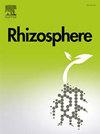Enhancing plant and soil health through organic amendments in a humid environment
IF 3.5
3区 生物学
Q1 PLANT SCIENCES
引用次数: 0
Abstract
Root distribution and soil characteristics significantly influence plant growth. Understanding the distribution of roots is essential for optimizing crop growth, soil health, and irrigation management. This research aimed to study the effects of type and rate of organic amendments (OA) on selected soil properties, root density, and distribution of roots in collard greens (Brassica oleracea var. viridis). A field experiment was conducted at Prairie View A&M University research farm in two seasons (October 2017 to April 2019). Three OA types, chicken manure (CM), dairy manure (DM), & milorganite (MG), were applied as treatments, including a control, to nine randomly selected plots (Total 9∗3 = 27 + 9 controls = 36 plots). One week before planting, these treatments were applied at three different rates as 168, 336, and 672 N-Kg/ha. Soil samples were collected from two depths (0–15 and 16–30 cm) to analyze the soil characteristics and quantify the root density and distribution of roots at the end of the growing season. Results showed that DM significantly increased total soil organic carbon (TOC) across all application rates and seasons. Bulk density in the surface layer decreased with OA application after 1.5 years. MG had the lowest root density and distribution of roots, possibly due to its slower nutrient release dynamics. The study determined that CM exhibited superior performance among the tested OA, resulting in enhanced root density and improved root distribution patterns, even at lower application rates (5.6 Mg/ha). These findings support the sustainable soil management practices by selecting appropriate soil amendments and application rates.
在潮湿环境中通过有机改良剂促进植物和土壤健康
根系分布和土壤特征对植物生长有显著影响。了解根系的分布对优化作物生长、土壤健康和灌溉管理至关重要。本研究旨在研究有机改良剂(OA)的种类和速率对甘蓝(Brassica oleracea var. viridis)土壤特性、根系密度和根系分布的影响。本研究分两个季节(2017年10月至2019年4月)在Prairie View A&;M大学研究农场进行了田间试验。三种OA类型,鸡粪(CM),乳粪(DM), &;在随机选择的9个地块(Total 9∗3 = 27 + 9个对照组= 36个地块)上,采用毫硅土(MG)作为处理,包括一个对照。在播种前1周,施用168,336和672 N-Kg/ha。在0-15 cm和16-30 cm两个深度采集土壤样品,分析土壤特征,量化生长季末根系密度和分布。结果表明,DM在不同施用剂量和季节均显著提高了土壤总有机碳(TOC)。施用OA 1.5年后,表层堆积密度下降。MG的根密度和根系分布最低,可能与养分释放动态较慢有关。研究表明,即使在较低的施用量(5.6 Mg/ha)下,CM在被试OA中表现出更优的性能,可以提高根系密度,改善根系分布模式。这些发现为选择适当的土壤改良剂和施用量提供了依据。
本文章由计算机程序翻译,如有差异,请以英文原文为准。
求助全文
约1分钟内获得全文
求助全文
来源期刊

Rhizosphere
Agricultural and Biological Sciences-Agronomy and Crop Science
CiteScore
5.70
自引率
8.10%
发文量
155
审稿时长
29 days
期刊介绍:
Rhizosphere aims to advance the frontier of our understanding of plant-soil interactions. Rhizosphere is a multidisciplinary journal that publishes research on the interactions between plant roots, soil organisms, nutrients, and water. Except carbon fixation by photosynthesis, plants obtain all other elements primarily from soil through roots.
We are beginning to understand how communications at the rhizosphere, with soil organisms and other plant species, affect root exudates and nutrient uptake. This rapidly evolving subject utilizes molecular biology and genomic tools, food web or community structure manipulations, high performance liquid chromatography, isotopic analysis, diverse spectroscopic analytics, tomography and other microscopy, complex statistical and modeling tools.
 求助内容:
求助内容: 应助结果提醒方式:
应助结果提醒方式:


